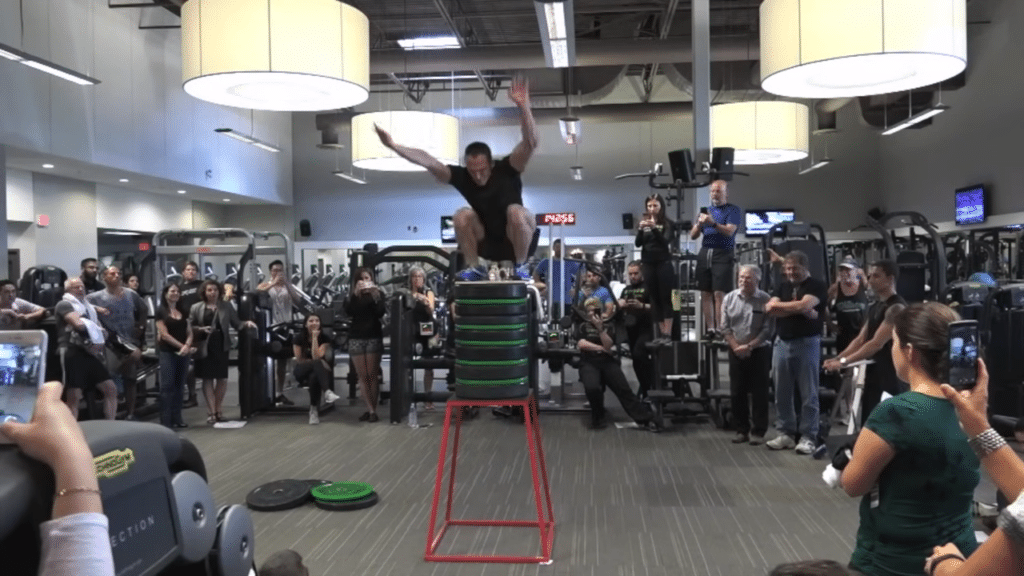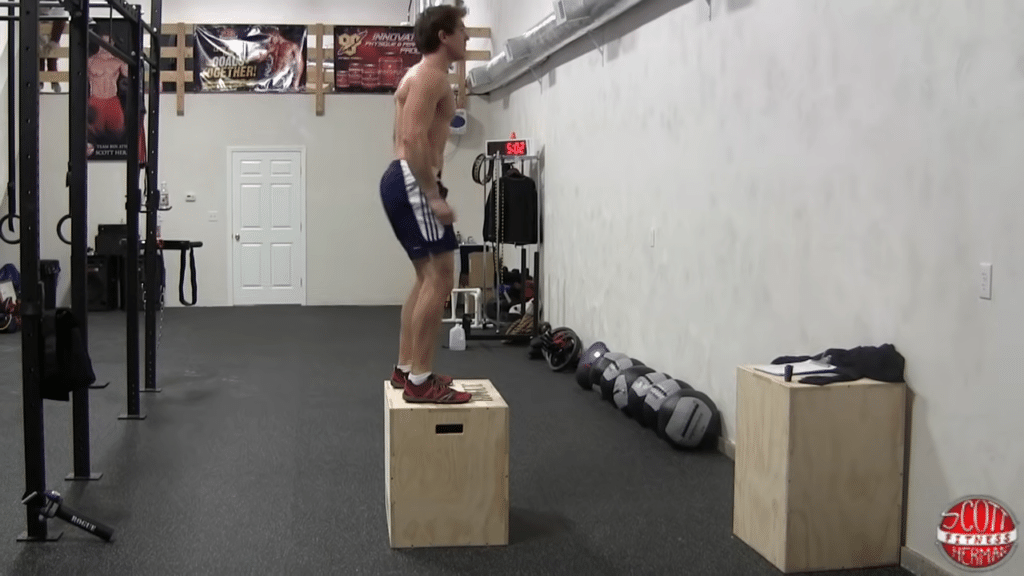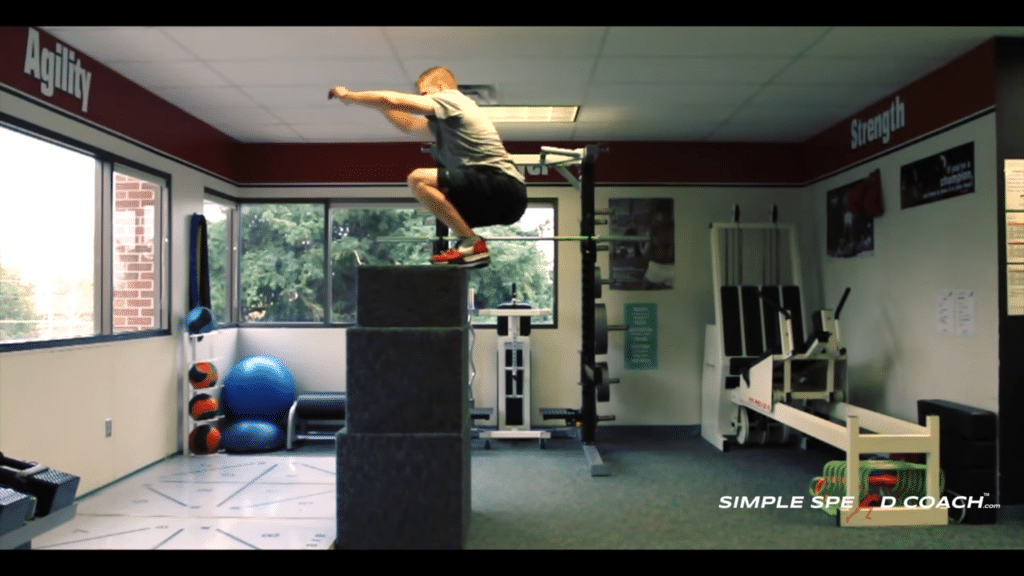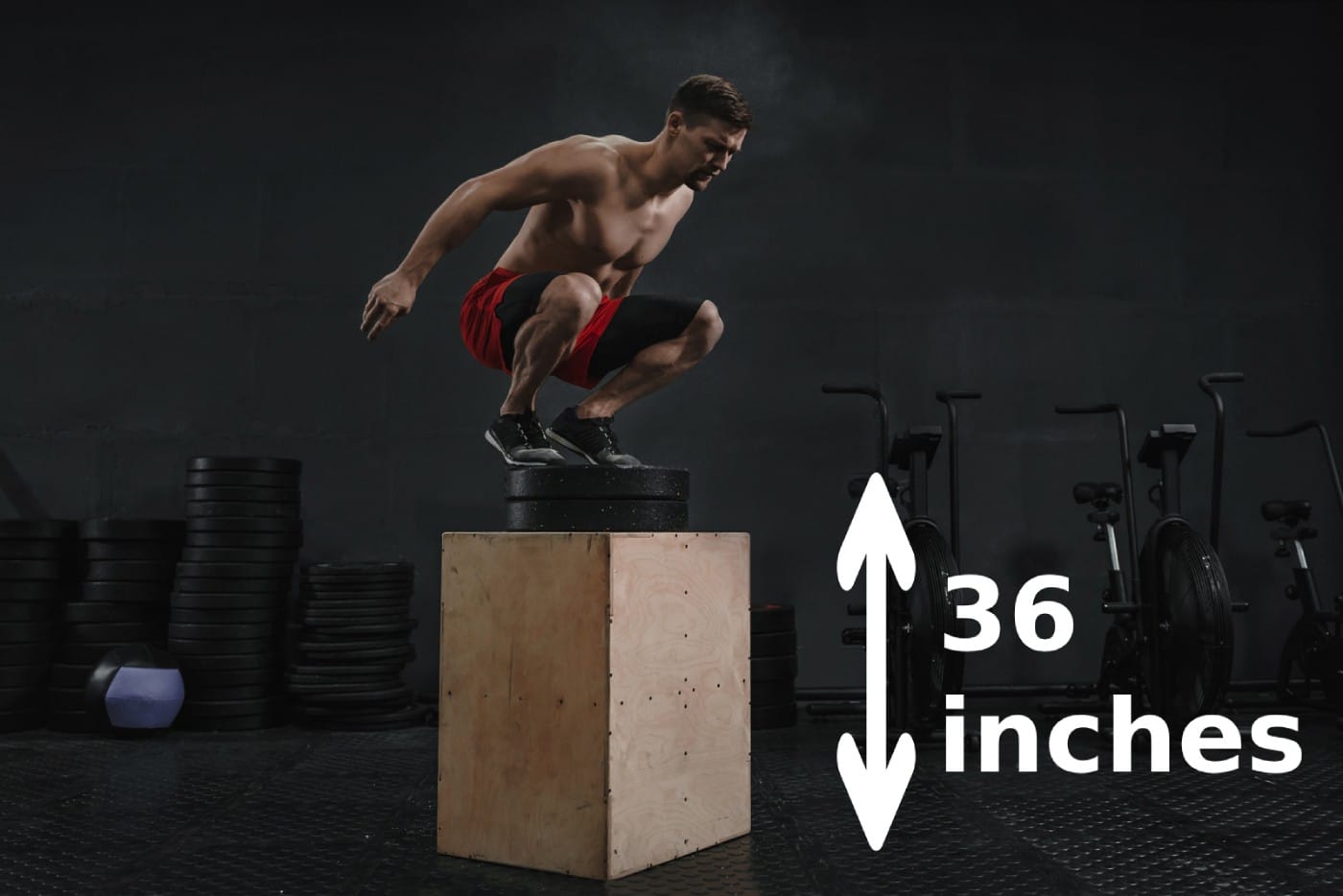Boost your athletic performance with box jumps, a potent plyometric tool.
This guide unravels the secrets to mastering this high-energy exercise, from perfecting your technique to maximizing strength and agility gains.
Uncover how tweaking box heights can tailor the challenge to your fitness level and explore variations that keep your routine fresh and effective.
Jump to:
Understanding Box Jumps
When I think about effective exercises for increasing power and improving athletic performance, box jumps immediately come to mind. They are a popular plyometric exercise, an integral component of my plyometric training sessions. Practicing box jumps means engaging in a high-intensity movement that requires me to explosively jump onto a raised platform, known as a box.
There’s a reason why plyo jumps are used by strength athletes.
Benefits of Box Jumps:
- Enhanced Athletic Performance: By incorporating box jumps into my fitness routine, I stimulate my fast-twitch muscle fibers. This helps in sports and activities that require bursts of power.
- Increased Explosive Strength: The dynamic nature of the movement increases my leg muscle power, which is crucial for sprinting, jumping, and lifting.
- Versatility: I can alter the intensity by changing the height of the box, making box jumps suitable for various fitness levels.
| Component | Description |
| Exercise Type | Plyometric |
| Primary Focus | Leg power, athletic performance |
| Equipment | Box or raised platform |
| Difficulty | Adaptable based on box height |
I find box jumps to be essential in my training because they contribute to a well-rounded exercise regimen. They are challenging yet modifiable, and they can bolster my overall fitness and physical health. As always, I perform box jumps with proper technique to minimize the risk of injury and to maximize the benefits of this compound plyometric exercise.
Box Jump Technique
In this section, I’ll guide you through the essentials of the box jump technique, focusing on the squat position, executing a powerful vertical jump, and mastering landing and rebounding effectively.
The Squat Position
To start a box jump, I firmly position my feet shoulder-width apart. I ensure my squat is deep enough to create potential energy for the jump. It’s crucial that my weight is on my heels and my chest remains up. As I squat, I swing my arms back to increase momentum.
The Vertical Jump
Subsequently, my arms thrust forward and upward as I explode in a vertical jump from the squat. During this phase, keeping my eyes on the box helps me maintain balance and focus. I concentrate on using the power generated from my legs and glutes to maximize my jump height.
Landing and Rebounding
Upon landing, I aim to have my feet flat on the box, absorbing the impact with my muscles rather than my joints. This soft landing is integral to prevent injury. For consecutive jumps or rebounding, I quickly jump back down, returning to the squat to complete the cycle, maintaining a rhythm that leverages my natural elasticity and muscle memory.
Optimizing Performance
In my training routines, I focus on enhancing performance by concentrating on explosiveness, speed, and power—three pillars that elevate athletic capability. This involves a regimented approach to plyometric exercises, ensuring each movement contributes to explosive strength necessary for peak performance.
Improving Explosiveness
To improve explosiveness, I incorporate movements that require rapid force development. Box jumps are a prime example, as they demand a quick, forceful contraction of the muscles. I focus on the pre-stretch or countermovement phase just before the jump, which can significantly impact the force produced. For instance, squatting down before jumping maximizes the use of the stretch-shortening cycle, a pivotal component of explosive movement.
Training for Speed and Power
My training sessions are not just about increasing power but also speed. Combining exercises like high-intensity interval training (HIIT) with plyometrics can enhance both qualities. I perform box jumps with varied intensity and volume—adjusting the box height or adding weights—to continuously challenge my leg muscles and central nervous system. Short bouts of intense box jumps are paired with adequate rest to prevent fatigue and maintain quality of movement.
Plyometric Exercise Variations
A variety of plyometric exercises are essential for all-round explosive power. I rotate through exercises such as squat jumps, depth jumps, and split squat jumps. Each variation targets different muscle groups and movement patterns, which is key to comprehensive plyometric training. Integrating exercises that mimic sport-specific movements allows for better transfer to athletic performance. I ensure that form and technique remain a top priority to avoid injury and get the most out of each session.

Muscular Engagement and Mechanics
In my experience with exercise physiology, box jumps are a dynamic plyometric movement that engage multiple muscle groups and demand proper mechanics for effectiveness and safety.
Primary Muscles Worked
Box jumps primarily target the lower body muscles including the glutes, hamstrings, and quadriceps. During the explosive upward phase of the jump, my quadriceps power the extension of the knees, while my glutes and hamstrings generate the hip extension necessary for the lift off. The eccentric portion, which involves landing back on the ground or on the box, further engages these muscle groups as they work to absorb the impact.
The Role of Core Stability
During box jumps, my core muscles play a crucial role in maintaining stability. A strong core is vital as it helps to control my body’s positioning throughout the jump and landing. Core engagement prevents excessive forward or lateral movement, thereby reducing the risk of injury and improving coordination. My core muscles act as stabilizers that allow for a safer and more controlled landing.
Box Jump Mechanics Explained

To perform a box jump efficiently, I must focus on the mechanics of the movement. The sequence starts with a squatting motion to load the muscles, followed by a rapid extension of my legs and hips to propel myself upwards. The coordinated effort of my quads, glutes, and hamstrings is pivotal here. When landing, whether on the box or back on the ground, proper landing mechanics involve a soft bend in the knees to absorb the impact and to prepare for subsequent jumps or movements. Proper coordination is essential to maintain momentum and to prevent strain on any single muscle group, ensuring a fluid and effective exercise.
Workout Structuring
Creating an effective plyometric workout involving box jumps requires careful consideration of the exercise structure to optimize performance and safety. I’ll guide you through the process of developing a routine tailored to your fitness objectives, covering how to design your training and determine the appropriate number of sets, reps, and rest periods.
Designing Your Plyo Box Routine
When structuring my plyometric box routine, I focus on quality and proper execution over quantity. Plyometric exercises should be integrated into the workout program based on goals and current fitness levels. A session may begin with a thorough warm-up, followed by complex movements like box jumps, and conclude with less intense exercises. It’s crucial to incorporate box jumps into the workout in a way that allows for full recovery between sessions to prevent overuse injuries. To achieve speed and quickness improvements, the routine should balance demanding exercises with lower impact activities.
Sets, Reps, and Rest Periods
For sets and reps, a starting point for beginners might be 2 to 3 sets of 6 to 8 reps with full recovery. As my proficiency with the exercise increases, I may increase the volume gradually, but typically no more than 40 jumps in a single workout to prevent fatigue and maintain form. It’s important to emphasize adequate rest periods, usually between 1 to 3 minutes, to allow for full creatine phosphate recovery. Rest periods can be adjusted if I am training for different outcomes, such as endurance or power, while carefully monitoring my body’s response to the workload.
Equipment and Setting
When I approach box jumps as part of my fitness routine, I ensure my equipment and environment are primed to support effective and safe workouts. Choosing the right box height and setting up the training area are pivotal elements to consider.
Choosing the Right Box Height

Selecting an appropriate plyo box height is crucial—I aim for one that challenges me without compromising technique. For beginners, research suggests starting with a lower box to focus on form. As confidence and skill increase, the box height can be increased incrementally. For instance, using two boxes, one at 24 inches for more advanced jumps and another at 8 inches for beginners, can cater to different skill levels and exercises within the same training session.
Setting Up Your Training Area
Safety is my top priority, so I arrange my training area with plenty of space and on flat, non-slip surfaces. This minimizes the risk of injury and allows ample room for a full range of motion. Weight and additional equipment are organized to avoid clutter. The environment where I train is kept free of distractions, ensuring focus and efficiency during each jump set.
Progression and Variability
Mastering box jumps requires understanding the importance of a structured progression plan and the role of exercise variability. I’ll walk you through how to smartly progress from beginner to more advanced levels and introduce variations that can enhance your training and prevent plateauing.
Box Jump Progressions for Beginners to Advanced
Starting with Box Jump Progressions for Beginners, I recommend initiating training with lower heights to focus on form and safety. The progression begins with simple movements like squat jumps to develop power. After mastering the squat jump, one progresses to step-ups, which help to build unilateral strength and stability—essential qualities for safe and effective box jumps.
Once comfortable, beginners can move on to a basic box jump, emphasizing the importance of landing softly with knees slightly bent. Intermediate progressions might include the seated box jump, which starts from a seated position, forcing the engagement of key muscle groups without the aid of momentum. Experienced individuals can further challenge themselves with depth jumps, where one steps off a box and immediately jumps vertically upon landing, promoting reactive power and speed.
- Beginner: Squat Jumps → Step-Ups → Low-Height Box Jumps
- Intermediate: Seated Box Jumps → Moderate-Height Box Jumps
- Advanced: Depth Jumps → High-Box Jumps
Incorporating Variations and Alternatives
I believe Variations and Alternatives can significantly enhance the standard box jump training routine. Adding variability not only combats the monotony of repetition but also recruits different muscle groups and stimulates adaptation. One variation, lateral box jumps, involves jumping sideways onto the box, which improves lateral movement and agility. Integrating alternative plyometric exercises, like depth jumps, can also prove highly beneficial for developing explosive power in ways that standard box jumps may not.
Another alternative to consider is the alternating step-up, which can improve coordination and serve as a precursor to more complex movements. For those seeking low-impact options, a step-up proves to be a safer variation that still strengthens the same muscle groups required for box jumps.
- Lateral Movements: Lateral Box Jumps
- Power Development: Depth Jumps
- Low Impact: Alternating Step-Ups, Step-Ups
Preparation and Safety
When I approach box jumps, my primary focus is on the proper form and warm-up techniques. These two elements ensure my safety and minimize the risk of injury during the exercise.
Proper Form for Injury Prevention
Positioning: Before I initiate a box jump, I make certain that I’m standing a comfortable distance from the box, allowing enough space to perform a pre-jump. My feet are positioned shoulder-width apart to provide balance and stability.
Jump Execution: I perform a slight knee bend followed by a quick extension of my legs and hips to propel myself upwards. Ensuring proper alignment of my knees and ankles is crucial—they should be pointing straight ahead, not inward or outward.
Landing: I aim for a soft landing on the box with my knees slightly bent to absorb the impact. This technique not only helps in reducing the risk of injury but also prepares me for a stable and controlled descent back to the starting position.
Ideal Warm Up Techniques
Dynamic Stretching: I engage in dynamic stretching to boost my hip mobility and overall flexibility before undertaking box jumps. Movements such as leg swings and walking lunges serve as excellent preparatory exercises.
Light Cardio: A short bout of light cardio such as jumping jacks or a brisk walk gets my heart rate up and muscles warm. This preps my body for the explosive movements involved in box jumps.
Practice Jumps: Before going for the actual box height, I perform a few low-impact jumps or step-ups to prime my nervous system. This prepares my body for the pattern of movement required in box jumps, enhancing both my performance and safety.
Common Mistakes and How to Avoid Them
When I perform box jumps, I’ve noticed several common mistakes among beginners and even experienced athletes. A typical error is improper landing technique, which elevates the risk of injury. To prevent this, I make sure to land with my feet flat and knees slightly bent to absorb the impact.
Moreover, I avoid jumping down from the box, as this can lead to unnecessary stress on the joints. Instead, I step down one foot at a time, maintaining control and minimizing injury risk.
Another frequent mistake is using a box that’s too high which can lead to falling. I recommend starting with a lower height and gradually increasing it as your confidence and abilities improve.
Here’s a quick rundown of mistakes and how to sidestep them:
- Inadequate warm-up: Always begin with dynamic stretches to prepare your muscles.
- Incorrect foot placement: Jump with your feet shoulder-width apart, and land softly.
- Overextending the knees: Keep your knees over your toes when landing to avoid strain.
- Losing focus: Stay concentrated on the box to prevent missteps or falls.
Maintaining proper form is vital for executing box jumps safely. If I’m unsure about my technique, I’ll consult a fitness professional to ensure that I’m performing the exercise correctly. By being mindful of these common box jump mistakes and consistently practicing proper form, I reduce my risk of injury and make the most out of this potent plyometric exercise.
References
- https://www.jsams.org/article/S1440-2440(09)00187-X/fulltext














